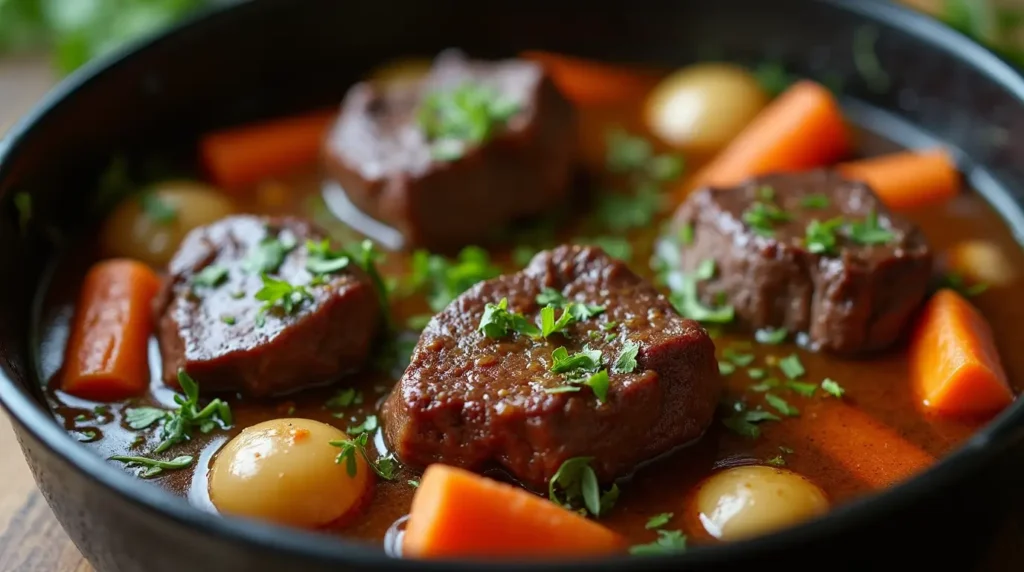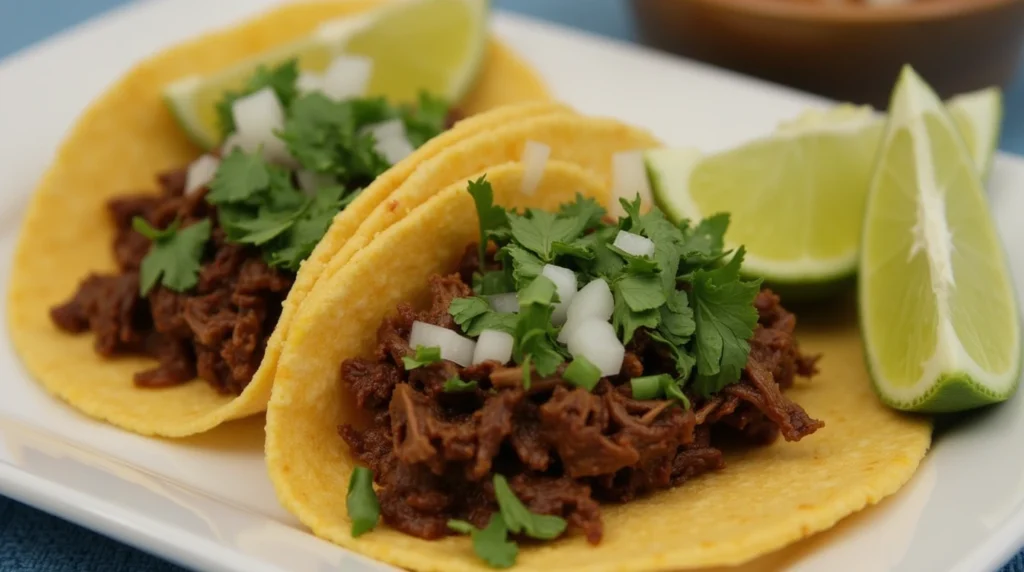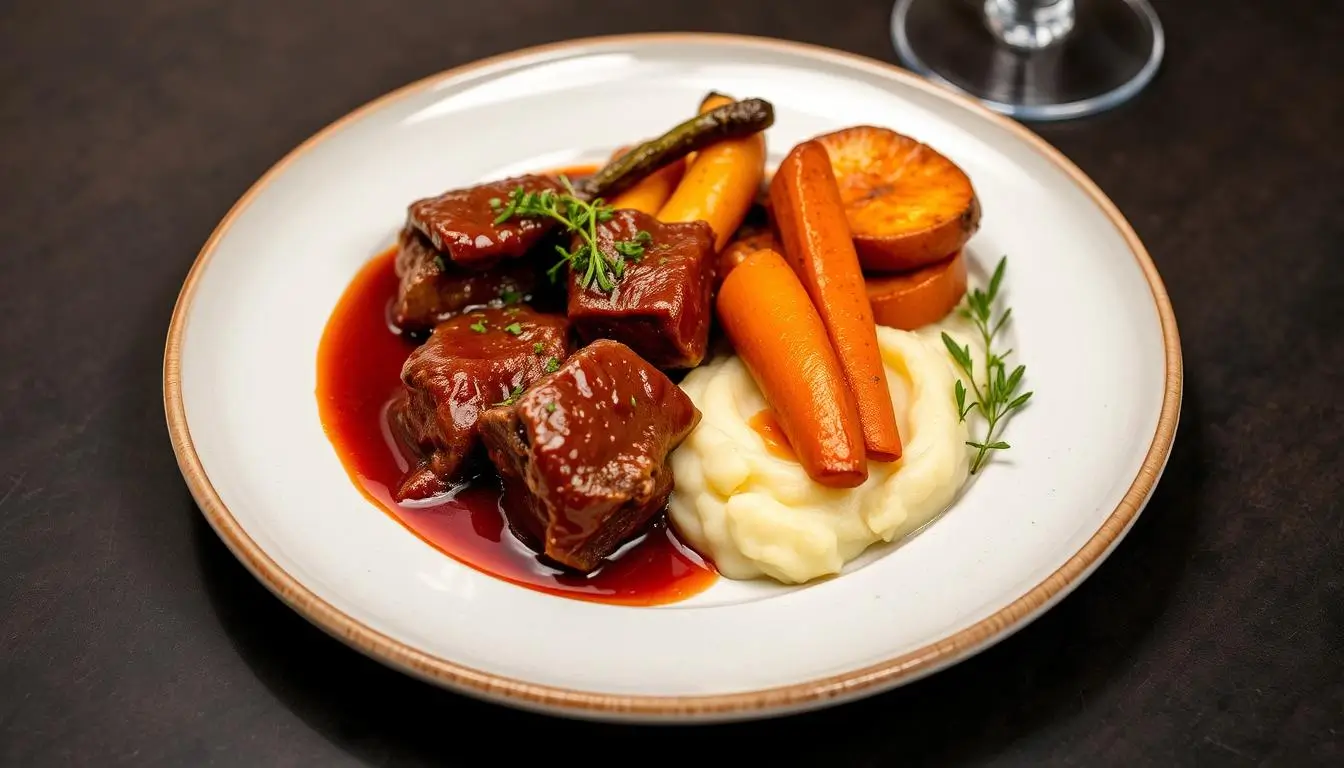Table of Contents
What is Beef Cheek Meat?
Beef cheek meat, derived from the facial muscles of the cow, is a lesser-known but highly esteemed cut of meat. This specific cut is prized for its remarkably rich flavor and luxurious texture, particularly when slow-cooked or braised. Read more about beef cheek meat and its culinary potential on Carnivore Style.
The cheeks are often utilized in gourmet dishes, where their unique taste can be highlighted, making them a favorite among chefs and culinary enthusiasts alike. As a meaty cut with high collagen content, beef cheek meat requires a lengthy cooking process to achieve the desired tenderness. Learn how to braise beef cheeks to perfection from The Irishman’s Wife. The low and slow cooking methods typically employed, such as braising or stewing, allow flavors to develop effectively, transforming this cut into a satisfying dish. Its adaptability to diverse cuisines, from traditional French preparations to modern fusion recipes, adds to its appeal.
In addition to its culinary merits, beef cheek is also notable for its nutritional attributes. A typical serving contains an impressive amount of protein, essential for muscle repair and growth. Furthermore, it includes vital vitamins and minerals such as iron, zinc, and B vitamins, all of which contribute to various bodily functions and overall health. Discover the surprising nutritional benefits of beef cheek meat on Meat Chef Tools.
Given its exceptional flavor and nutritional profile, beef cheek meat stands out as a superior choice for those aiming to indulge in both taste and healthfulness in their meals.
Cooking Tips for Beef Cheek Meat
Cooking beef cheek meat to achieve that ideal tenderness requires a mastery of various techniques. One of the most effective methods for preparing this cut is slow cooking. This process allows the collagen within the meat to break down gradually, resulting in a buttery texture. Consider using a slow cooker or a Dutch oven, filled with a flavorful broth that complements the beef. The key is low and slow—set the temperature low and allow the meat several hours to transform into a tender delight.
Another excellent technique is braising. This method involves searing the beef cheeks first to develop a rich, brown crust, which adds an explosion of flavor. After searing, they are cooked covered in a mix of wine, stock, or other braising liquid on low heat. Braising not only tenderizes the meat but also infuses it with the aromatic qualities of the liquid. Cooking the beef for an extended time in this environment enhances its flavor profile, creating a dish that is succulent and vibrant.
Marinating is also integral to preparing beef cheeks. A well-thought-out marinade can penetrate the meat, enriching it with flavors. Ingredients such as balsamic vinegar, soy sauce, or even yogurt can work wonders, tenderizing the beef while imparting unique tastes. Combining spices and herbs like rosemary, thyme, or garlic creates a bouquet of flavors that will elevate the dish. Allow the meat to marinate overnight for maximum effect.
For those looking to enhance their culinary endeavors, consider adding complementary flavors through additional spices. Using a mix of smoked paprika, cumin, or even a touch of chili can introduce warmth and depth, transforming an ordinary dish into a culinary masterpiece. By employing these cooking techniques and flavor enhancement options, your beef cheek meat dishes will undoubtedly impress.
Delicious Beef Cheek Meat Recipes
Beef cheek meat is known for its rich flavor and tender texture when cooked properly. Below are three delightful recipes that highlight this unique cut, catering to various culinary preferences and cooking methods.
Braised Beef Cheeks

For a classic dish that brings out the depth of flavor in beef cheeks, braising is an excellent technique. To prepare, you’ll need 2 pounds of beef cheeks, 1 chopped onion, 2 sliced carrots, 2 minced cloves of garlic, 1 cup of red wine, 2 cups of beef broth, and herbs such as thyme and bay leaves.
Start by searing the beef cheeks in a hot pan until browned on all sides. Remove them from the pan, then add onions, carrots, and garlic, sautéing until softened. Pour in the red wine to deglaze, scraping up any browned bits. Return the beef to the pot, add the broth and herbs, cover, and let simmer on low heat for 4-5 hours until the meat is fork-tender.
Slow Cooker Beef Cheeks
A slow cooker beef cheek recipe provides a hands-off approach that yields exquisite results. Begin with 2 pounds of beef cheeks, 1 onion (chopped), 3 cloves of garlic (minced), 1 teaspoon of paprika, 1 can of diced tomatoes, and 1 cup of beef broth. Place the beef cheeks at the bottom of the slow cooker, layer in the onions, garlic, and spices, then pour over the tomatoes and broth. Cook on low for 8 hours or on high for 4 hours. The beef will become incredibly tender, perfect for serving alongside mashed potatoes or crusty bread.
Beef Cheek Tacos

For a fun and flavorful meal, consider preparing beef cheek tacos. Begin by shredding cooked beef cheeks from the previous recipes or by slow-cooking them with spices such as cumin and chili powder. Serve the shredded meat on corn or flour tortillas and top with diced onions, cilantro, and a squeeze of lime. These tacos are not only easy to make but also bring a delightful taste experience, showcasing the versatility of beef cheek meat.
Whether braised, slow-cooked, or transformed into tacos, beef cheek meat offers a wealth of flavor and tenderness that can elevate any meal. Enjoy experimenting with these recipes to discover your own favorite preparations.
Perfect Side Dishes for Beef Cheek Meat
When preparing a dish centered around beef cheek meat, selecting appropriate side dishes is essential to create a well-rounded meal that enhances the rich, deep flavors of the beef. Creamy mashed potatoes, roasted root vegetables, and creamy polenta are three exceptional side dishes that pair beautifully with beef cheek meat.
First, let’s consider creamy mashed potatoes. This classic side dish is a staple for many hearty meals. To prepare, you will need:
- 2 pounds of Russet potatoes
- ½ cup of heavy cream
- ¼ cup of unsalted butter
- Salt and pepper to taste
Begin by peeling and chopping the potatoes into equal-sized pieces. Boil them in salted water until tender. Drain the potatoes and return them to the pot, adding in the butter and heavy cream. Mash to your desired consistency and season with salt and pepper. The creaminess of this dish contrasts perfectly with the robust flavors of beef cheek meat.
Next, roasted root vegetables bring an earthy touch that complements beef cheek meat wonderfully. For this dish, gather:
- 3 carrots, peeled and sliced
- 2 parsnips, peeled and sliced
- 1 sweet potato, cubed
- 2 tablespoons olive oil
- 1 teaspoon rosemary
Toss the vegetables in olive oil, rosemary, salt, and pepper, then spread them on a baking sheet. Roast at 425°F (220°C) for 25-30 minutes or until golden brown. Their sweetness beautifully highlights the savory notes of beef cheek meat.
Finally, creamy polenta is an excellent choice as a side dish. To prepare this dish, you will need:
- 1 cup of coarse cornmeal
- 4 cups of water or broth
- ½ cup of grated Parmesan cheese
- Salt and butter to taste
Bring the water or broth to a boil, slowly whisk in the cornmeal, and reduce the heat. Stir until the polenta thickens. Finish by stirring in butter and Parmesan cheese for extra creaminess. This dish’s smooth texture and mild flavor are a delightful accompaniment to flavorful beef cheek meat.
By incorporating creamy mashed potatoes, roasted root vegetables, and creamy polenta, you can create a harmonious meal that enhances the luxurious taste of beef cheek meat while providing a delightful contrast in textures and flavors.
Exploring Beef Cheek Meat Variations
Beef cheek meat is gaining recognition across various culinary traditions, celebrated for its rich flavor and versatility. This delectable cut of meat has found its way into dishes from many different cultures, showcasing a wide range of preparations and flavor profiles. Its ability to absorb different spices and cooking techniques makes beef cheeks an excellent choice for a multitude of recipes, enhancing their appeal across diverse cuisines.
One of the most iconic dishes featuring beef cheeks comes from Mexican cuisine: Carnitas. In this preparation, beef cheeks are slowly braised with aromatic spices and citrus, resulting in incredibly tender meat that can be shredded and served in tacos or burritos. The slow cooking process allows the beef to become infused with the bold flavors, highlighting the meat’s natural richness.
Across the Atlantic, in French cuisine, Beef Bourguignon exemplifies another exceptional preparation of beef cheeks. Traditionally cooked in red wine with onions, mushrooms, and herbs, this dish epitomizes the phrase “comfort food.” The long simmering time is essential for the meat, which becomes meltingly tender and deeply flavorful, perfectly illustrating how different cooking styles can transform beef cheeks into a gourmet experience.
In Asian cuisine, notably in Korean dishes, beef cheeks are often marinated and cooked to achieve a balance of sweet, savory, and spicy notes. Korean BBQ highlights this cut, with marinated pieces grilled to perfection, allowing diners to enjoy the unique texture and flavors. This technique reflects the cut’s adaptability to varying flavor profiles while maintaining its tenderness through proper cooking.
Ultimately, the variations in beef cheek meat preparations across global cuisines enhance its popularity. As chefs and home cooks alike continue to experiment with this cut, incorporating international flavors and techniques will inspire dishes that satisfy a range of palates. Whether exploring traditional recipes or putting a modern spin on classic dishes, beef cheeks offer an exciting culinary adventure worth pursuing.
Storing and Preparing Beef Cheek Meat
To maintain beef cheek meat’s quality, refrigeration and freezing methods must be executed thoughtfully. When purchasing beef cheeks, refrigerate them if they are to be used within a few days. Store the meat in its original packaging or in an airtight container to prevent spoilage. The ideal refrigeration temperature is below 40°F (4°C). For longer storage, freezing is best. Wrap the meat tightly in plastic wrap or aluminum foil, then place it in a freezer-safe bag. This method minimizes freezer burn and preserves quality for up to six months.
Thawing beef cheek meat should be done cautiously to retain texture and flavor. The safest method is transferring the meat from the freezer to the refrigerator, allowing it to thaw gradually over 24 hours. For quicker thawing, place the sealed meat in cold water for several hours, ensuring the packaging remains intact to prevent water absorption.
Once thawed, start the preparation phase by trimming excess fat from the beef cheeks, as it can hinder the desired tenderness during cooking. Ensure uniformity in the size of meat pieces to enhance cooking consistency. When cutting the beef cheeks, slice against the grain to reduce muscle fiber length, leading to a more tender bite. Use a sharp knife for precise cuts, enhancing meat presentation and cooking efficiency while maximizing tenderness.
Common Mistakes to Avoid
In this guide, we have delved into the remarkable world of beef cheek meat, highlighting its versatility and the myriad of opportunities it presents in the kitchen. This cut of meat, while often overlooked, can transform ordinary dishes into extraordinary culinary experiences when prepared with the right techniques.
We explored various cooking methods, including braising, slow cooking, and pressure cooking. Each of these methods is suitable for bringing out the rich flavors and tender textures characteristic of beef cheeks.
The diverse range of recipes shared throughout the blog not only showcases the adaptability of this ingredient but also encourages creative experimentation. Whether you prefer classic preparations like beef cheek stew or innovative dishes such as tacos de lengua, the potential to customize flavors and pair with various side dishes is immense.
The inclusion of aromatic herbs, spices, and vibrant sauces allows each chef to personalize their dishes, making beef cheek meat a unique centerpiece for any meal.
As you embark on your culinary journey with beef cheek meat, remember that this cut invites exploration. Try new recipes, pair it with diverse sides such as creamy polenta, roasted vegetables, or hearty grains. Discover how this unassuming ingredient can elevate your dining experience.
Health Benefits of Beef Cheek Meat
Beef cheek meat, often regarded for its rich flavor and texture, offers several significant health benefits that make it a valuable addition to a balanced diet. One notable aspect of beef cheek meat is its impressive nutritional profile. A typical serving contains a substantial amount of protein, which plays a crucial role in muscle repair and growth. Protein is not only vital for athletes and individuals engaged in physical activities but also essential for maintaining overall body health.
In addition to protein, beef cheek meat is an excellent source of several important vitamins and minerals. It is particularly high in vitamin B12, which is essential for the formation of red blood cells and the maintenance of a healthy nervous system. B12 deficiency can lead to serious health complications, underscoring the importance of including this nutrient in one’s diet. Furthermore, beef cheek meat contains iron, a mineral vital for transporting oxygen throughout the body. Adequate iron intake is crucial for preventing anemia and maintaining energy levels.
The collagen content present in beef cheek meat is another health advantage worth noting. Collagen is known to support skin elasticity and joint health, thereby potentially reducing the risk of injuries and aging effects. When cooked slowly, beef cheek meat becomes remarkably tender, making it an ideal ingredient for hearty, nutritious meals. By incorporating this flavorful cut into your culinary repertoire, you not only enhance your dishes but also contribute positively to your health.
Ultimately, adding beef cheek meat to your diet can provide a wealth of nutrients, supporting muscle repair, boosting energy levels, and promoting optimal overall wellness. Its rich flavor profile and nutritional benefits make it a desirable choice for those looking to improve their diet while enjoying delicious dishes.
Conclusion: Elevating Your Culinary Experience
In this guide, we have delved into the remarkable world of beef cheek meat, highlighting its versatility and the myriad of opportunities it presents in the kitchen. This cut of meat, while often overlooked, can transform ordinary dishes into extraordinary culinary experiences when prepared with the right techniques.
We explored various cooking methods, including braising, slow cooking, and pressure cooking. Each of these methods is suitable for bringing out the rich flavors and tender textures characteristic of beef cheeks.
The diverse range of recipes shared throughout the blog not only showcases the adaptability of this ingredient but also encourages creative experimentation. Whether you prefer classic preparations like beef cheek stew or innovative dishes such as tacos de lengua, the potential to customize flavors and pair with various side dishes is immense.
The inclusion of aromatic herbs, spices, and vibrant sauces allows each chef to personalize their dishes, making beef cheek meat a unique centerpiece for any meal.
As you embark on your culinary journey with beef cheek meat, remember that this cut invites exploration. Try new recipes, pair it with diverse sides such as creamy polenta, roasted vegetables, or hearty grains. Discover how this unassuming ingredient can elevate your dining experience.
Embracing the use of beef cheek meat enhances your cooking repertoire and promotes an appreciation for the depth of flavor achieved through mindful preparation and homage to traditional cooking methods.
Enjoy the process of cooking with beef cheeks, and may your dishes be filled with richness and satisfaction.


2 thoughts on “Beef Cheek Meat: Discover the Secrets to Perfectly Tender Dishes”
Comments are closed.